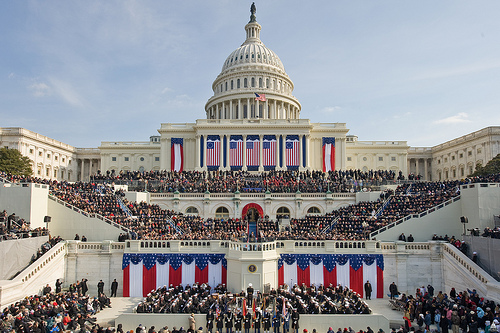Obama inaugural officials tight-lipped at press conference
Officials with President Obama's inaugural committee took questions from reporters Wednesday at the National Press Club but the answers were less than illuminating. Here's the rundown:
- Q. Why is the committee providing less information on donors than former President George W. Bush, and Obama himself did in earlier inaugurals?
- A. That was then. This is now.
"Each one of these is created anew every four years," Brent Colburn, communications director for the 2013 Presidential Inaugural Committee, said of the more parsimonious disclosure strategy. Because the PIC isn't legally required to report its donors to the Federal Election Commission until 90 days after the inauguration, Colburn touted the existing donors list on its website as "our attempt to go above and beyond that and add a level of transparency."
What he didn't add is that it's below and behind what Obama provided in 2009, when he began disclosing donors earlier and provided far more information, including the amount of money they gave.

- Q. What is the PIC's fundraising goal?
- A. We're not saying, even though it's been reported.
"We haven't been discussing the goal publicly," Colburn said when asked about reports that the committee is trying to raise $50 million. While he wouldn't confirm the goal, Colburn nonetheless "I can tell you that we are on track to meet it." The number is not being disclosed, deputy communications director Rachel Racusen later told Sunlight, because it's a moving target. How much the committee ends up spending and whether it has anything left over never has to be made public; all the committee is required to give the FEC is a list of people who gave more than $200 and the amount of their contributions.
- Q. If there are leftover funds, which in the past have been used for Bill Clinton's presidential library foundation and Barbara Bush's literacy organization, where will they go?
- A. TBD
Colburn said he does not know what the plans are for any surplus but added that there are a number of "civic-minded things I think we'll be able to do if we're lucky enough to have excess funds."
- Q. Why has the PIC attracted eight corporate donors in a year when the president lifted the ban he established on corporate donations to his 2009 inaugural?
- A. Just you wait.
"Contributions are still coming through the door," Colburn said, adding that a new list of donors will be posted on the committee's website Friday.
- Q. What is the overall cost of the inauguration?
- A. TBD
Colburn said it was too early to tell because of the many different organizations involved in planning and "moving budgets." "That's something we'll be able to speak to more after the event actually occurs and we tally up some of these bills," he said.
Here's what is known: The inaugural committee only pays for part of the inauguration budget. The group pays for Monday's parade and balls, along with the National Day on Service Saturday, happening nationwide, and a concert for children of military families on Saturday night.
Meanwhile, taxpayers cover the cost of security, emergency services and transportation for the events. The governments of The District of Columbia, Maryland and Virginia requested $75 million from the federal government for such costs in 2009, which set a record for attendance at any event in Washington, D.C. history. The Joint Inaugural Committee on Inaugural Ceremonies, an official group chaired by Sen. Chuck Schumer, D-N.Y., and paid for with taxpayer money, covers the cost of the president's swearing-in at the Capitol. Among other things, that covers construction of an elaborate, bunting-festooned deck along the West Front of the Capitol where the Congress and other VIPs sit to witness the swearing-in of the president and vice president, and an exclusive bipartisan lunch for senior members of Congress and the president afterwards in Statuary Hall, the original House chamber.
(Photo credit: Architect of the Capitol via Flickr)

